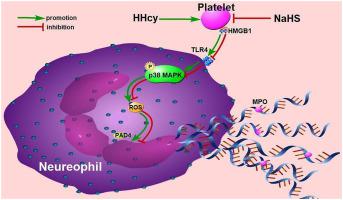Biochemical and Biophysical Research Communications ( IF 2.5 ) Pub Date : 2020-12-28 , DOI: 10.1016/j.bbrc.2020.12.059 Xueying Zhao 1 , Liyuan Zhang 1 , Xin Liu 2 , Ziqing Zhao 3 , Xin Zhong 2 , Yuwen Wang 1

|
Hydrogen sulfide (H2S) prevents platelet activation and neutrophils extracellular traps (NETs) formation. However, the mechanism of sodium hydrosulfide (NaHS, a donor that produces H2S) inhibits the formation of NETs in hyperhomocysteinemia (HHcy) rats has not been previously investigated. In the experiment, the expressions of HMGB1 of platelets, the expressions of TLR4, PAD4 and the phosphor-p38 of neutrophils were measured. The NETs formations, the concentration of DNA in the serum and the culture solution of cultured neutrophils which was stimulated by platelet-rich plasma (PRP) were tested. Additionally, the cellular ROS level and SOD activity were detected. The platelets were activated and the expression of HMGB1 of platelets and NETs formation, the concentration of DNA, and the expressions of TLR4, phosphor-p38 and PAD4, the ROS level were all increased while the activity of SOD decreased in the HHcy group compared to the control group. NaHS significantly inhibited the activation of platelets, the production of ROS and the formation of NETs in neutrophils, reversed the expressions of HMGB1, TLR4, phosphor-p38, PAD4 and decreased concentration of DNA which was caused by high homocysteine. Our results demonstrate that the donor of H2S inhibits NETs formation of neutrophils via the HMGB1/TLR4/p38 MAPK/ROS pathway in hyperhomocysteinemia.
中文翻译:

外源性硫化氢通过 HMGB1/TLR4/p-38 MAPK/ROS 轴抑制高同型半胱氨酸血症大鼠中性粒细胞胞外陷阱的形成
硫化氢 (H 2 S) 可防止血小板活化和中性粒细胞胞外陷阱 (NET) 形成。然而,硫氢化钠(NaHS,一种产生H 2 S的供体)抑制高同型半胱氨酸血症(HHcy)大鼠中NETs形成的机制尚未被研究过。实验中检测血小板HMGB1的表达量、中性粒细胞TLR4、PAD4及磷酸化p38的表达量。检测富血小板血浆(PRP)刺激后血清和培养中性粒细胞培养液中NETs的形成、DNA浓度。此外,还检测了细胞ROS水平和SOD活性。与HHcy组相比,HHcy组血小板被激活,血小板HMGB1表达、NETs形成、DNA浓度、TLR4、p38、PAD4表达、ROS水平均升高,SOD活性降低。对照组。 NaHS显着抑制血小板活化、ROS产生和中性粒细胞NETs形成,逆转HMGB1、TLR4、p38、PAD4的表达以及高同型半胱氨酸引起的DNA浓度降低。我们的结果表明,在高同型半胱氨酸血症中,H 2 S 供体通过 HMGB1/TLR4/p38 MAPK/ROS 通路抑制中性粒细胞的 NET 形成。















































 京公网安备 11010802027423号
京公网安备 11010802027423号